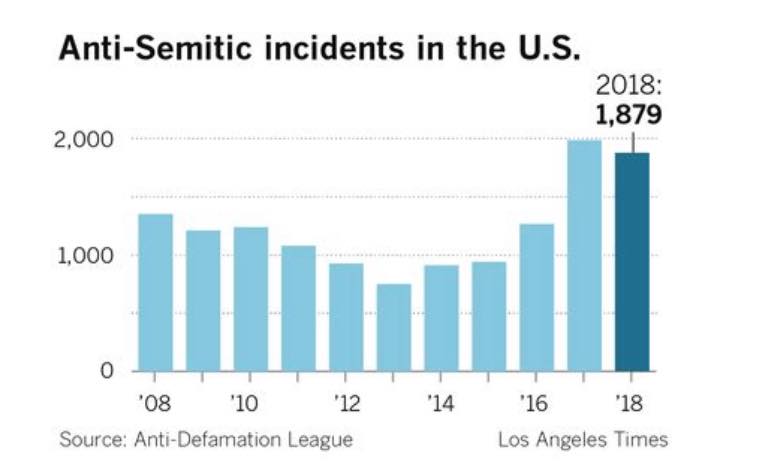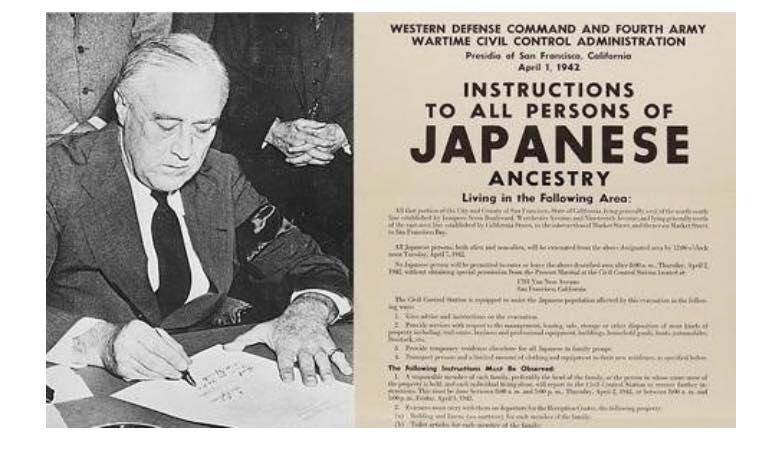CommentsVOICES-The mainstream press is filled with stories about violent “anti-Semitic” (i.e. anti-Jewish) incidents in the United States, as well as a large march against anti-Semitism in New York City.
To better understand the significance of these actions, I examined the Anti-Defamation League’s (ADL incident database. Since it’s founding in 1913, the ADL has closely monitored a broad range of anti-Jewish actions in the United States. These records not only include violent attacks, such as those in Pittsburg, Poway, and Monsey, NY, but also the lynching of Leo Frank; rampant discrimination in employment, housing, academia, and private clubs; restrictive immigration laws; malicious media stereotypes; large Nazi public meetings (see Madison Square Garden photo above), and prejudiced attitudes measured by public opinion polls.
Year-after-year the ADL’s annual inventory of anti-Semitic incidents has been the best source of historical data, and it allows us to place the recent surge of anti-Jewish attacks in historical perspective.

The ADL data indicates that anti-Jewish incidents gradually declined from 2008 to 2013 but increased steadily since 2013. This increase closely parallels the general increase of overall hate crimes in the United States since 2016.
The ADL’s most recent l survey, from 2018, provides the most accurate data available on overt anti-Jewish actions. While the 2019 report is likely to document an increase in anti-Jewish incidents, especially against Chassidic Jews in the New York metropolitan area; it is unlikely to record a return of blatant anti-Semitism in the United States, as described below.
-- Despite a long history of discriminatory immigrations laws against Jewish refugees, largely from 1920 to the 1960s, there is no evidence that Jews immigrating to the United States face discriminatory treatment or are – like Muslim and Latino immigrants, refugees, and asylum seekers -- denigrated as criminals, rapists, and terrorists.
-- According to historian, David Wyman, in the 1930s and 1940s Jewish K-12 students were regularly assaulted on their way to and from school. In contrast, the 2018 ADL report documents two assaults against Jewish students. The remaining 455 incidents involving K-12 students were not assaults but acts of harassment and school vandalism.
-- Despite a long history of discrimination in employment, private club, and housing against American Jews from the 1880s through the 1950s, the ADL report did not document any discrimination. It is also likely that the 2019 survey will confirm this since American Jews no longer face discrimination, a basic component of racism.
-- Likewise, there was no evidence in the ADL report that anti-Jewish discrimination returned academia. What previously took the form of exclusion from fraternities and sororities, college and medical school admission quotas, glass ceilings that blocked Jewish professors from becoming college presidents, deans, and department chairs completely disappeared by the late 1960s.
-- In earlier periods of American history, the media widely distributed anti-Jewish stereotypes and conspiracy theories. These included weekly diatribes in the 1930s from Father Charles Coughlin in his nationally broadcast Social Justice radio show, Henry Ford’s widely reprinted series, The International Jew, and many articles by Nazi sympathizers, like Charles Lindberg. In contrast, the ADL’s 2018 report does not mention any anti-Jewish stereotypes or conspiracy theories appearing in radio, television, film, or print.
-- Anti-Jewish bigotry, as measured by public opinion polls, peaked in 1944-5, when half the US population held strong anti-Jewish prejudices. Now, 75 years later, two recent ADL surveys found that 14 percent of the US population holds anti-Jewish views, and that those 39 or younger are free of prejudice. This once common bedrock of anti-Semitism has almost disappeared from American life.
-- Despite the continuous refrain from the Israeli government and many of its U.S. supporters that criticism of Israel’s human rights record stems from Jew-hatred, the ADL does not report that any groups critical of Israel’s human rights engaged in vandalism against Jewish institutions, physical attacks on Jews, and anti-Jewish emails, phone calls, graffiti, or fliers. As for Jewish and non-Jewish groups that support the Boycott, Divestment, and Sanctions (BDS) movement, the ADL’s 2018 survey does not document any anti-Jewish incidents linked to these groups or their members.
The ADL’s findings should be carefully considered when forecasting future anti-Jewish actions in the United States. Could there be more attacks on synagogues, like those in Pittsburgh, Poway, and Monsey, New York? Absolutely.
Could these anti-Jewish attacks morph into harassment and summary executions by local police departments, similar to the daily experiences of Blacks and Latinos? This is highly unlikely. In fact, the ADL report does not document any police violence of harassment directed at American Jews.
Would Jews attempting to immigrate to the United States be either barred, like they were from 1920 through WWII, as were Chinese immigrants until 1964, and Latino and Muslims at present? This too is highly unlikely, and the ADL report does not mention any calls or actions to restrict Jewish immigration to the United States.
Will discrimination return to academia, housing, private clubs, fraternities and sororities, as well as to the workplace? This too is unlikely, and there is no evidence of any anti-Jewish discrimination like this in the most recent ADL report.
Will nationally syndicated radio and TV shows again traffic in anti-Jewish stereotypes and conspiracy theories? While this is certainly possible, the ADL focuses on the dark recesses of the Internet, where hate groups peddle their toxic brew.
Will Nazis, neo-Confederates, and other racist groups again flourish in the United States, like they did in the 1930s, when they could fill Madison Square Garden with 20,000 racists in Nazi regalia? (See photo above.) Possibly, but unlikely. If this happens, though, we can be thankful that anti-racist groups, like Antifa, are ready to act quickly to make sure history does not repeat itself.
Will Jews by subject to pogroms in the United States, like they were in Czarist Russia? While Phillip Roth created a small fictional pogrom in his alternative history, The Plot Against America, the likelihood of American pogroms, similar to those targeting American Blacks after WWI or Latinos in Los Angeles during WWII, is remote. The ADL does not even mention this possibility in its 2018 report.
Could American Jews be rounded up and sent to concentration camps, like Japanese Americans were in 1942 during WWII through President Franklin Roosevelt’s Presidential Proclamation 2537? This is highly unlikely, and the ADL also makes no mention of this in its publications.

Those who predict history seldom get the story right. Nevertheless, an economic crisis in conjunction with a major foreign war, such as the one that Trump might stumble into with Iran, could become a catalyst for expanded political surveillance and repression, militarism, racism, bigotry, and flag-waiving nationalism (i.e. fascism).
If American fascism comes to pass, American Jews need to remember that it is related to a much larger surge in racism. Furthermore, Blacks, Latinos, and Muslims are ahead of them in line. The joint struggle against racism directed at these groups is, therefore, the first line of Jewish defense.
Furthermore, Jews who succumb to racism, such as Steven Miller, the White House’s chief xenophobe, or Israeli politicians intent on building an apartheid state, are not allies. Their policies endanger American Jews and should be rejected.
(Victor Rothman is a California-based policy analyst. He can be reached at [email protected].) Prepped for CityWatch by Linda Abrams.
















